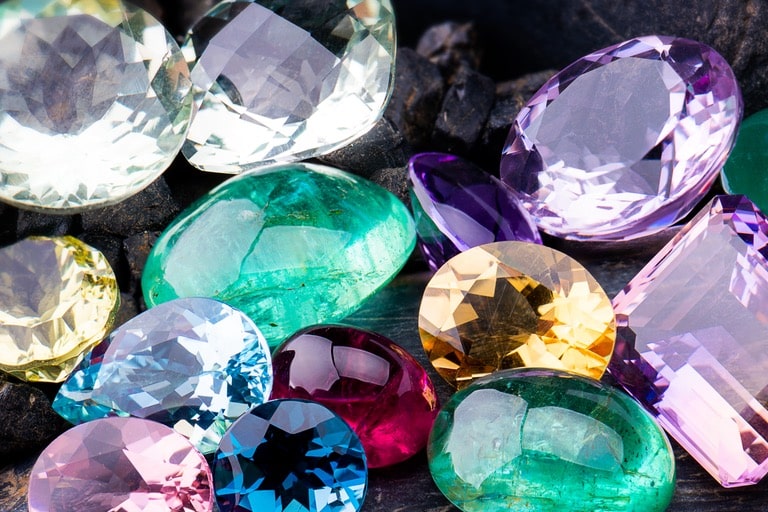Birthstones are gems linked to each month of the year, possessing rich histories and cultural meanings. They are often thought to bring good fortune and protection to those who wear them.
For those born in the summer months of June, July, and August, the respective birthstones are Pearl (and Alexandrite), Ruby, and Peridot.
These stones are not just beautiful to behold. Each carries its own unique lore, historical background, and symbolism that has been cherished across various cultures and civilizations for centuries.
Let’s look into the captivating world of summer birthstones to uncover their rich histories and the intriguing stories behind their enduring allure.
June: Pearl
The origin of pearls has long intrigued civilizations throughout history, as noted by the Gemological Institute of America.
In ancient Middle Eastern cultures, pearls were believed to be teardrops from the heavens, whereas Chinese mythology suggested they came from a dragon’s brain. During Christopher Columbus’s era, the common belief was that pearls formed from dew drops.
Organic pearls develop within the tissue of living saltwater or freshwater mollusks, such as oysters or mussels. Pearls are created when a mollusk secretes nacre around an irritant, such as a grain of sand or a parasite that enters its shell.
Due to extensive pearl fishing over millennia, natural pearl beds have been largely depleted, making cultured pearls the primary source of pearl sales today. Cultured pearls are available in a wide variety of sizes, colors, and shapes.
Symbolism
Pearls symbolize purity, innocence, and faith. They are often associated with weddings and are said to bring marital bliss. Because they are created by living organisms (mollusks), pearls are also considered symbols of life and fertility.
July: Ruby
Rubies have been valued for thousands of years, particularly in Asian cultures, according to the American Gem Society. Historical documentation suggests that as far back as 200 BC, rubies were exchanged along China’s North Silk Road. Chinese noblemen often embellished their armor with rubies, believing the gems would provide protection.
Burma (now Myanmar) has been a significant source of rubies since 600 AD, producing some of the most coveted rubies in the world. After the exhaustion of the conventional Burmese mines, ruby production commenced in the Mong Hsu area of Myanmar during the 1990s.
Although these rubies initially lacked the rich red color of traditional Burmese rubies, they were commonly heat-treated to enhance their saturation. This process improves transparency and is now a standard practice in the ruby industry.
Notably, as per Leibish, the red color of this precious gem is due to a small amount of chromic oxide mixed into the mineral.
Symbolism
The ruby July birthstone symbolizes passion, protection, and prosperity. Its vibrant red color is associated with love and intense emotions, making it a popular choice for engagement rings and romantic gifts.
August: Peridot
According to Dreweatts, Peridot has been treasured as a gemstone for approximately 3,500 years.
Historical documents from around 1500 BC reveal that peridot mining took place on an island known as Topazios to the Greeks and Romans. Currently, this island is recognized as Zabargad Island in the Red Sea.
Known as the ‘gem of the sun’ by the Ancient Egyptians, they believed it descended to Earth from a supernova explosion. Peridot remains Egypt’s national gem today.
Revered for its association with light, it was believed to provide protection from the darkness of the night, ensuring a peaceful sleep. Additionally, it was worn tied to donkey hair and around the arms to ward off malevolent spirits.
Symbolism
Peridot symbolizes strength, as well as prosperity and growth. It is also considered a stone of compassion, believed to bring good health, restful sleep, and peace to relationships by balancing emotions and mind.
FAQs
What is the historical significance of Pearls?
Pearls have been cherished for centuries for their natural beauty and are often associated with purity and wisdom.
What makes Ruby a notable birthstone for July?
Ruby is prized for its rich red color and is often associated with passion, love, and vitality.
How was Peridot used in ancient times?
Peridot was used to protect against the ‘terrors of the night.’ It was tied with donkey hair and worn around the arms to fend off evil spirits.
In conclusion, the history and lore of summer birthstones are as rich and varied as the stones themselves. These gems add beauty and elegance to jewelry and carry deep symbolic meanings and fascinating histories that enhance their allure.
Whether worn for their aesthetic appeal or their believed mystical properties, summer birthstones are a cherished and timeless part of human culture.
